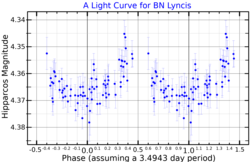 A light curve for BN Lyncis, plotted from Hipparcos data | |
| Observation data Epoch J2000 Equinox J2000 | |
|---|---|
| Constellation | Lynx |
| Right ascension | 08 22 50.11000 |
| Declination | +43° 11′ 17.2724″ |
| Apparent magnitude (V) | +4.25 |
| Characteristics | |
| Spectral type | K4+ III |
| B−V color index | 1.550±0.003 |
| Variable type | SRd |
| Astrometry | |
| Radial velocity (Rv) | +24.56±0.22 km/s |
| Proper motion (μ) | RA: −25.16±0.36 mas/yr Dec.: −99.23±0.21 mas/yr |
| Parallax (π) | 8.53 ± 0.25 mas |
| Distance | 380 ± 10 ly (117 ± 3 pc) |
| Absolute magnitude (MV) | −1.09 |
| Details | |
| Mass | 1.95±0.18 M☉ |
| Radius | 53.27+1.64 −1.55 R☉ |
| Luminosity | 782.4±60.3 L☉ |
| Surface gravity (log g) | 1.46±0.12 cgs |
| Temperature | 3,921±19 K |
| Metallicity | −0.06±0.05 dex |
| Age | 1.32±0.23 Gyr |
| Other designations | |
| Alsciaukat, 31 Lyn, BN Lyn, NSV 4030, BD+43°1815, FK5 314, GC 11401, HD 70272, HIP 41075, HR 3275, SAO 42319 | |
| Database references | |
| SIMBAD | data |
31 Lyncis is the fourth-brightest star in the constellation of Lynx. It has the traditional name Alsciaukat, pronounced /ælʃiˈɔːkæt/. The orange-hued star is visible to the naked eye with a baseline apparent visual magnitude of +4.25. It is a single star located about 380 light years away from the Sun, based on parallax, and is moving further away with a heliocentric radial velocity of +25 km/s.
This object is an aging giant star with a stellar classification of K4+ III. A 1993 study found that it varied in brightness by 0.05 magnitude over 25 to 30 days. On the other hand, a 2002 study of the Hipparcos data found a period of 3.5 days. It is classified as a semiregular variable with a brightness that ranges from 4.21 to as low as 4.27, and has the variable star designation BN Lyncis.
31 Lyncis is 1.3 billion years old with almost double the mass of the Sun. With the supply of hydrogen at its core exhausted, the star has expanded to 53 times the Sun's radius. It is radiating around 782 times the Sun's luminosity from its swollen photosphere at an effective temperature of 3,921 K.
Nomenclature
31 Lyncis is the star's Flamsteed designation.
It bore the traditional names Alsciaukat, from Arabic الشوكة aš-šawkat "the thorn", and Mabsuthat, from Arabic المبسوطة al-mabsūtah "the outstretched (paw)". In 2016, the International Astronomical Union (IAU) organized a Working Group on Star Names (WGSN) to catalog and standardize proper names for stars. The WGSN approved the name Alsciaukat for this star on 30 June 2017 and it is now so included in the List of IAU-approved Star Names.
References
- "/ftp/cats/more/HIP/cdroms/cats". Centre de Données astronomiques de Strasbourg. Strasbourg astronomical Data Center. Retrieved 3 December 2022.
- ^ van Leeuwen, F. (2007). "Validation of the new Hipparcos reduction". Astronomy and Astrophysics. 474 (2): 653–664. arXiv:0708.1752. Bibcode:2007A&A...474..653V. doi:10.1051/0004-6361:20078357. S2CID 18759600.
- ^ Ducati, J. R. (2002). "VizieR Online Data Catalog: Catalogue of Stellar Photometry in Johnson's 11-color system". CDS/ADC Collection of Electronic Catalogues. 2237. Bibcode:2002yCat.2237....0D.
- ^ Keenan, P.; McNeil, R. (October 1989). "The Perkins catalog of revised MK types for the cooler stars". Astrophysical Journal Supplement Series. 71: 245–266. Bibcode:1989ApJS...71..245K. doi:10.1086/191373.
- ^ Anderson, E.; Francis, Ch. (2012). "XHIP: An extended hipparcos compilation". Astronomy Letters. 38 (5): 331. arXiv:1108.4971. Bibcode:2012AstL...38..331A. doi:10.1134/S1063773712050015. S2CID 119257644.
- ^ Samus, N. N.; Kazarovets, E. V.; Durlevich, O. V.; Kireeva, N. N.; Pastukhova, E. N. (2017). "General Catalogue of Variable Stars". Astronomy Reports. 5.1. 61 (1): 80–88. Bibcode:2017ARep...61...80S. doi:10.1134/S1063772917010085. S2CID 125853869.
- ^ Baines, E.; et al. (2017). "Fundamental Parameters of 87 Stars from the Navy Precision Optical Interferometer". The Astronomical Journal. 155 (1): 30. arXiv:1712.08109. Bibcode:2018AJ....155...30B. doi:10.3847/1538-3881/aa9d8b. S2CID 119427037.
- ^ Sharma, Kaushal; Prugniel, Philippe; Singh, Harinder P. (2016). "New atmospheric parameters and spectral interpolator for the MILES cool stars". Astronomy & Astrophysics. 585: 27. arXiv:1512.04882. Bibcode:2016A&A...585A..64S. doi:10.1051/0004-6361/201526111. S2CID 118576178. A64.
- "27 Lyn". SIMBAD. Centre de données astronomiques de Strasbourg. Retrieved 2019-06-06.
- ^ "Naming Stars". IAU.org. Retrieved 16 December 2017.
- Eggleton, P. P.; Tokovinin, A. A. (September 2008). "A catalogue of multiplicity among bright stellar systems". Monthly Notices of the Royal Astronomical Society. 389 (2): 869–879. arXiv:0806.2878. Bibcode:2008MNRAS.389..869E. doi:10.1111/j.1365-2966.2008.13596.x. S2CID 14878976.
- Percy, John R. (1993). "The photometric variability of K giants". Publications of the Astronomical Society of the Pacific. 105 (694): 1422–26. Bibcode:1993PASP..105.1422P. doi:10.1086/133324.
- Koen, Chris; Eyer, Laurent (March 2002). "New periodic variables from the Hipparcos epoch photometry". Monthly Notices of the Royal Astronomical Society. 331 (1): 45–59. arXiv:astro-ph/0112194. Bibcode:2002MNRAS.331...45K. doi:10.1046/j.1365-8711.2002.05150.x. S2CID 10505995.
- Allen, Richard Hinckley (1963) . Star Names: Their Lore and Meaning (Reprint ed.). New York, NY: Dover Publications Inc. p. 280. ISBN 0-486-21079-0.
- "IAU Working Group on Star Names (WGSN)". Retrieved 22 May 2016.